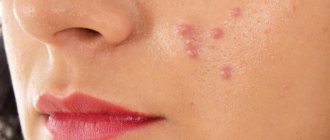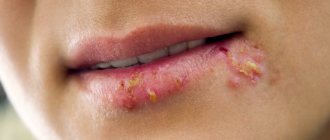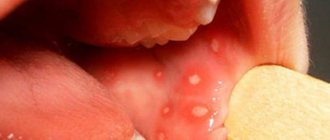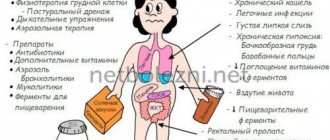Mouth pain is most often caused by infection, allergies, or injury. A sore throat can easily be confused with pain in the mouth.
THE DOCTOR'S CONSULTATION
Contact your doctor if your child:
- refuses to drink for a long time due to pain in the mouth
- he has a mouth ulcer that has not healed for more than a week
- swelling of the gums, lips, palate
ATTENTION!
Pain in the mouth can lead to a child refusing to drink for a long time, and this is dangerous due to the risk of dehydration.
| ASK YOURSELF A QUESTION | POSSIBLE REASON | WHAT TO DO |
| Is your baby breastfed and has small sores on your tongue? | Incorrect attachment during breastfeeding | Ulcers are formed from pressure from the nipple when the baby is not latched onto the breast incorrectly and go away when proper latching is established. Try changing your feeding position. You can contact a lactation consultant for help in establishing proper feeding. If inflammation or other symptoms occur, contact your child's doctor . |
| Has your child's drooling increased? Does he keep his finger(s) in his mouth all the time? Is he 4-8 months old? | Teeth cutting | If these symptoms are accompanied by signs of illness (fever, loss of appetite, etc.), call your child's doctor for an examination. The appearance of teeth alone cannot cause a high temperature. Some children find it easier if they are given special rubber rings to chew on; others like to live cool objects (see Toothache) |
| Is your baby hungry but refusing to nurse? Are there white spots on the tongue and inside of the cheeks? Did he take antibiotics? | Thrush | This is a fungal disease and can be caused by taking antibiotics. Consult your child's doctor . A good remedy is to treat your mouth with a soda solution. Sometimes it is necessary to take antifungal agents. |
| Is your older child complaining of pain when swallowing? | Viral or bacterial (streptococcal) infection | Take your child to the pediatrician . He will prescribe the necessary treatment |
| Do you have small, painful sores on your tongue and inside your cheeks? | Ulcerative stomatitis | Take your child to the pediatrician. He will prescribe the necessary treatment |
| Painful yellowish spots or blisters on the tongue, gums, inner cheeks, swelling and redness of the oral mucosa? Enlarged cervical lymph nodes, “cold” on the lip? Are your lips bright red, swollen, painful? Temperature 37.5-39 C? Loss of appetite, headache, drooling? | Herpetic or other viral infection | Call a doctor and follow all his instructions. A sick child should have separate dishes; isolation is required. Paracetamol will help with pain and fever. Give non-carbonated, non-acidic drinks (water, milk, milkshakes); broths |
| Are your lips dry and bright red? Are there peeling and cracks in the corners of your mouth? | Seizures (cheilitis); may be caused by B vitamin deficiency or food allergies | Talk to your child's doctor . Use hygienic lipstick, baby cream, especially in cold weather |
| Does your child have a constant sore on the tip or edge of his tongue or one sore on the inside of his cheek? | Biting with a tooth | Contact your dentist |
| Does your child have sores on his tongue or on the inside of his cheek? Is he taking any medication, such as an anticonvulsant or an antibiotic? | Possible side effects of the medication | Show your child to the pediatrician - he will recommend what to do |
FOR INFORMATION
"Geographical" language
A healthy tongue is pink in color, its upper surface is covered with papillae surrounded by taste endings. Sometimes parents notice with concern that the child’s tongue is covered with bright red spots with white borders and resembles a map. The spots are painful and appear and disappear. This inflammation of the tongue is the so-called harmless migratory glossitis. It does not require treatment. The reason is not known for certain.
Features of the development of the disease
In a healthy child, the secretions secreted by the sinuses (sinuses) freely pass through the anastomosis into the nasal cavity and exit through the nostrils. If infectious pathogens enter the sinuses that the child’s fragile immunity is not able to cope with:
- the mucous membrane swells;
- natural air exchange is disrupted;
- favorable conditions are created for the proliferation of pathogenic microflora;
- mucus accumulates;
- mucus thickens and expands the sinuses, periodically flowing out;
- thickened mucus provokes purulent sinusitis;
- pus enters the blood and ENT organs.
Make an appointment right now!
Call us by phone or use the feedback form
Sign up
The mechanism of occurrence is indicated from acute to advanced chronic form. The process can be interrupted at any stage by promptly contacting an ENT specialist. Parents delay visiting the clinic, confusing the symptoms with a common runny nose or a cold. Contact us when the baby’s condition does not improve for more than 3 months, the disease becomes chronic. At this stage, curing a child is much more difficult. Long-term use of antibiotics will be required, which will have a negative effect on the child’s body.
Duration of stages:
- acute – 1-20 days;
- subacute – 20-90 days;
- chronic – from 90 days.
The first 10 days the runny nose does not go away.
To restore the balance of microflora, a balanced diet and vitamin complexes are required. It is important to follow the recommendations of your doctor and not interrupt the course of medications until complete recovery. Do not try to cure congestion in the bridge of the nose with massage; a sharp outflow of mucus into the brain and deformation of the cartilage are possible.
How is scarlet fever treated?
Even without treatment, most children and adults with group A streptococcal infections recover on their own. Some children who are not treated with antibiotics develop complications, including ear infections, sinusitis, tonsil abscesses, lymph node infections, or pneumonia. A rare but very serious complication of scarlet fever is the development of rheumatic heart disease, a condition that affects the valves and function of the heart. Therefore, to prevent such severe complications and prevent the spread of infection, children are prescribed antibiotic therapy. Most often, doctors prescribe penicillin or amoxicillin for a course of 10 days. For allergies to penicillins, erythromycin is used.
What types of inflammation are there?
Inflammations are classified according to the area affected:
- maxillary sinus – sinusitis;
- frontal - frontal sinusitis;
- ethmoid – ethmoiditis;
- wedge-shaped – sphenoiditis.
By nature, the causative agent of inflammation can be: viral, bacterial, fungal. By the number of affected sinuses: monosinusitis - one sinus, polysinusitis - several, pansinusitis - all. Unilateral inflammation of all sinuses – hemisinusitis. From the above classification it follows that unilateral sinusitis is monosinusitis; bilateral – polysinusitis.
According to the characteristics of the course - acute, subacute, chronic. The nature of the inflammation is catarrhal (liquid mucus is present), purulent (the mucus is thick), mixed.
Classification is necessary for correct diagnosis. To prescribe the optimal course of treatment, diagnostic accuracy is important when distinguishing between acute, subacute and chronic exacerbation. Only a doctor can determine the differences between these forms with almost identical symptoms, but with different treatment regimens, based on the results of a comprehensive diagnosis.
It is impossible to determine the stage of progression based on signs and symptoms. The course of the disease depends on the state of the body and the influence of external factors.
If a child twitches his ear, is he sick?
A child's habit of touching his ears does not necessarily indicate otitis media. The baby may simply be interested in exploring her ears, or she likes to pull on them, or her teething irritates the nerve endings and causes the baby to constantly pull on her ears. But if the baby’s increased interest in his ears is combined with crying, irritability, fever, runny nose, conjunctivitis, or a cold in general, you should take this signal seriously. Very often, intuition helps attentive mothers to notice and recognize an ear infection in a child in time - especially when they already know what it is and how it can manifest itself.
Causes of the disease
The disease occurs for the following reasons:
- ARVI,
- asthma;
- childhood diseases - measles, rubella, mumps;
- weakening of the immune system – activation of opportunistic microflora;
- allergic swelling, usually systematic;
- fungal microorganisms;
- adenoids;
- benign or malignant formations;
- anomalies of the anatomical structure of the sinuses;
- diabetes, leukemia;
- increased ocular and intracranial pressure - chronic, exacerbations with increased pressure;
- injuries, periodic bleeding;
- inhalation of polluted air;
- diseases of the respiratory tract, accompanied by sputum production and high fever, dry cough - damage to the mucous membrane of the ENT organs, rapid development of pathologies of cartilage tissue, eustachian tubes - the disease becomes complex;
- frequent use of folk remedies based on honey, iodine, hydrogen peroxide, antiseptic solutions - the acute form becomes chronic several times faster;
- long-term use of nasal drops – addiction, symptoms worsen;
- infectious diseases of the oral cavity, benign and malignant formations;
- mechanical damage and infection.
90% of the causes of the disease are viruses, about 10% are bacterial in nature, and a small proportion are fungal pathogens. With fungal etiology, the disease quickly turns into a purulent form.
Why are ear infections so common in children?
Let's take a look into the middle ear to understand why small ears so often suffer from pathogens. The canal, called the Eustachian (auditory) tube, connects the nasopharynx and the middle ear cavity and performs many important functions: it helps to compare pressure, provides ventilation and protection. But it is in the nasopharynx that most bacteria find nutritious moisture and a breeding ground. Since in a child the Eustachian tube is short, wide and placed horizontally, it is easier for mucous discharge from the throat and nose, as well as any microorganisms in them, to enter the middle ear cavity through it. The child’s immune system has not yet been fully formed, and therefore is vulnerable - it needs more time to fight many unfamiliar bacteria. This is how otitis media often develops in many young children.
Symptoms of sinusitis in a child
In children, the disease becomes purulent more quickly than in adults. Symptoms are less pronounced due to the small size of the sinuses. Since the child in most cases cannot talk about the symptoms on his own, the ENT specialist recommends that parents determine the baby’s condition based on the signs.
Symptoms:
- nasal congestion for more than 10 days;
- pain in the area of inflammation, increasing when the head is tilted;
- headache;
- body temperature: chronic - up to 37.5, acute - up to 38, purulent - 39 and above;
- dry cough.
Any illness without medical help will have negative consequences for the body.
Friends! Timely and correct treatment will ensure you a speedy recovery!
Important advice: if a child has a temperature of 37.1-37.5, has a runny nose, or headaches, it is advisable to consult a doctor. A common runny nose can cause hearing loss and speech defects. Advanced diseases are very difficult to treat. A runny nose can cause thyroid dysfunction: coccus bacteria consume iodine, decreased gonadotropin production, lymph condensation reduces thyroid metabolism.
How does acute sinusitis manifest?
The main signs that it is recommended to pay attention to:
- redness of the eyes, in the nostrils, swelling of the bridge of the nose, nasal voice;
- constant discharge of mucus or pus;
- if there is a concomitant ENT disease or fungal nature, there may be a lack of departments;
- if the cause is a herpes virus, formations are possible in the mouth, nostrils, and on the outside of the wings of the nose;
- loss of appetite, lethargy;
- swelling of the bridge of the nose;
- breathing only through the mouth due to pain in the nose, radiating to the forehead.
You should not treat even a mild runny nose in a child on your own. Drops with vegetable oils clog the ciliated epithelium and cause allergies. This especially applies to the anastomosis connecting the sinuses. This condition may be a sign of sinusitis.
How does the infection spread?
The causative agents of scarlet fever and streptococcal sore throat are transmitted by airborne droplets when there is contact with airborne biofluids that are formed when an infected person talks, coughs or sneezes. These droplets can get into the eyes, nose, or mouth when the child is near an infected person. The droplets do not remain in the air - they usually spread a meter or one and a half and fall to the ground.
Infection is also possible through contact with respiratory secretions or with objects contaminated with such secretions (handkerchiefs, napkins, toys, dishes).
Direct bodily contact with an infected person (touching skin, kissing, etc.)
Possible complications
Doctors recommend seeking medical help if you have at least 2 of the above signs and symptoms and if nasal congestion lasts more than 10 days. Otherwise, the following complications are possible:
- complete or partial loss of smell, vision, hearing;
- meningoencephalitis;
- phlegmon of the orbit of the eye;
- inflammatory process in bone tissue;
- vein thrombosis;
- meningitis;
- conjunctivitis;
- brain abscess;
- internal hydrocephalus;
- lymphadenitis.
The advanced form of sinusitis is more difficult to cure.
Brain abscess and meningoencephalitis can be fatal. Purulent stagnation often leads to autoimmune diseases - massive devouring of dead phagocytes by living ones. Signs: ankylosis of joints, changes in skin pigmentation, bleeding. Possible death. The degree of damage to the body is determined by a rheumatologist and immunologist.
Why is it important to properly treat children's ears?
Your child's hearing depends on the proper vibration of the eardrum and the condition of other parts of the middle ear. Repeated infections can damage the eardrum, while the accumulation of fluid in the middle ear cavities negatively affects (sort of dampens) the vibration of the eardrum - ultimately, both interfere with the baby's normal hearing. This is why it is important to take ear infection treatment seriously, especially as your child learns to speak. Partial hearing loss can lead to delayed speech development or even pronunciation problems, which will later affect the child’s speech habits and success in learning.
What signs of the disease are assessed by the doctor?
When collecting an anamnesis and examining a child, the doctor will pay attention to the following symptoms:
- Onset and duration of sore throat
- Severity of fever
- Associated cough, runny nose, conjunctivitis, headache, myalgia (muscle pain)
- Any difficulty breathing, especially snoring at night or stridor
- History of rash, diarrhea, or allergies
- Regurgitation (reflux of gastric contents into the esophagus), pain in the epigastric or retrosternal region.
- Family history of sore throat in the past 2 weeks.
- Similar complaints in the past,
- Vaccination history
When examining the throat, the doctor may reveal:
- White or gray plaques on the surface of the tonsils or pharynx that rub off easily without bleeding.
- Ulcerations
- Plaques in the form of films, characteristic of infectious mononucleosis, diphtheria and sometimes streptococcal infection. Tularemia can also be a rare cause of such plaques.
- Films of gray or black color, extending beyond the tonsils, with swallowing problems and the absence of severe fever, are characteristic of diphtheria.
- Oral thrush, which is common in newborns and infants, may have a pseudomembrane (curdled plaques), the removal of which can cause mild pinpoint bleeding.
- Convexity of the oropharynx or lateral displacement of the uvula indicates a parapharyngeal or peritonsillar abscess.
- Herpetic sore throat is characterized by painful vesicular (bubble-like) formations on the pharynx and tonsils. Herpes simplex causes painful blisters limited to the front of the mouth, which can sometimes spread to the front of the tonsils.
- Lymphadenopathy (enlarged and painful anterior and posterior cervical lymph nodes is characteristic of bacterial tonsillitis or Epstein-Barr virus infection.
- Streptococcal pharyngitis is characterized by sore throat, temperature ≥38.3°C, tonsil and pharyngeal plaque, and cervical lymphadenopathy.
- Cough, runny nose and diarrhea are more common with viral pharyngitis.
Still have questions?
Get an online consultation from leading pediatricians in St. Petersburg!
A professional and experienced pediatrician will answer your questions.
Medical care for a child without leaving home at a convenient time.
sign up for a consultation
A Skype consultation lasts 45 minutes.
What is a fever?
The normal temperature for babies and children is around 36.4°C, but this may vary slightly from child to child.
- Low-grade fever is an increase in temperature from 36.7 to 38 degrees.
- Fever is a high temperature of 38 C or more.
The following symptoms appear when you have a fever:
- Your baby's forehead, back, or stomach feels hotter than usual.
- The surface of the skin becomes sweaty (moist) and sticky.
- The baby's cheeks and sometimes forehead turn red.
To measure temperature, it is best to use a safe digital thermometer without mercury filling.








